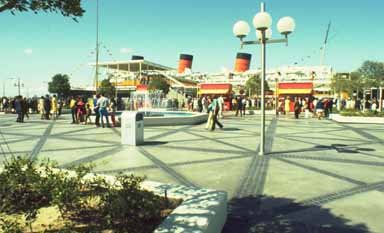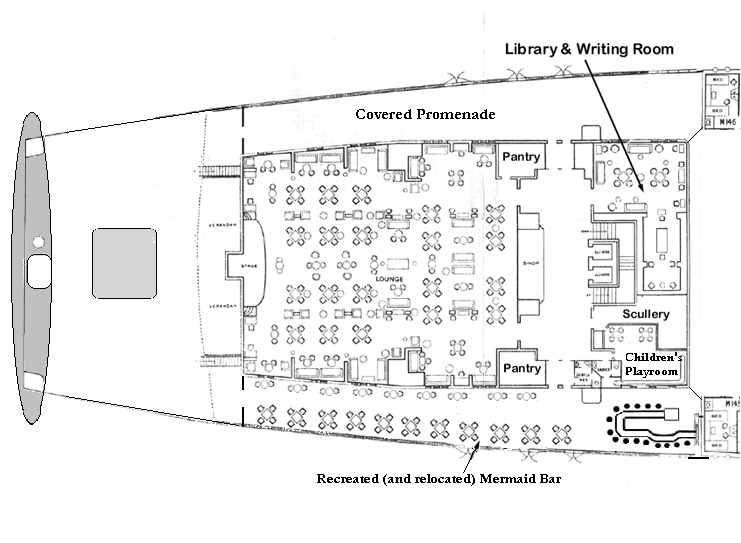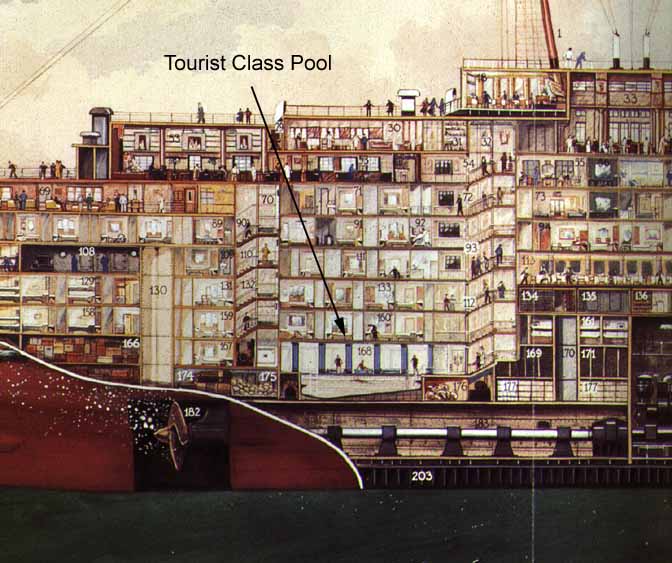
In 1971 the New York Times sent a reporter to visit the Queen Mary as she completed her first season as a mass tourist attraction in Long Beach, California. Impressed with the scope of the effort, if not with its finesse, the reporter found that many of the shopkeepers aboard the ship were struggling to survive. The masses of tourists had not resulted in significant retail sales. The merchants' hoped for salvation was a delayed four-star hotel operation that they expected to open the following year. It would bring aboard better heeled and more liberal-spending customers, they reasoned.

The Queen Mary shortly after opening in 1971. The hotel was not open at this time.
While wishing the best for the great ship that was once a beloved feature of the New York City landscape, the reporter wondered whether a first class hotel could ever find an appreciative audience in the middle of a tourist attraction.
As it turned out the common sense misgivings of the New York Times reporter were well founded: the hotel that opened in 1972 failed to attract the type of clientele that the shops required to thrive or even survive. All of those on Sun deck have long since closed and the space is now given up to other uses or remains empty. The better-located shops on Promenade deck have fared a little better, but the village of shops that opened on the property in the mid-1970’s is a ghost town in all but name. It is currently slated for demolition.
The new hotel was in fact a downscaled and down classed version of the four star hotel first envisioned by consultants to the city of Long Beach prior to the ship’s purchase in 1967. It ended up being little more than three decks of cabins sandwiched between a tourist attraction and a catering facility. Though the cabins were spacious by ship standards – then and now – they were only about half the size of a typical first class hotel room found ashore. Few if any amenities were reserved for hotel guests on the tourist ship. Many of them had in fact been removed from the ship during the conversion:
|
The gymnasium, and cabins on Sun Deck that the city’s consultants initially saw as part of the hotel or an ancillary club had been gutted for supposedly more commercially lucrative tourist shops. These were the very shops the New York Times reporter found struggling for survival by the end of their first tourist season. |
|
The large tourist class lounge on Main deck that Diner’s club had envisioned as a venue in which to recreate an elegant and private shipboard atmosphere for hotel guests was instead stripped of its furnishings and reassigned to the banqueting catering service. |
|
The first class swimming pool was rendered unusable by the conversion, the Turkish baths had been gutted and the equally elegant second class pool and gymnasium on the aft lower deck were removed to make room for new tourist exhibit space and public lavatories. |
|
The barbershop and beauty parlor rhapsodized about in early Long Beach promotional materials about the expected world class hotel facility that the ship was to be, were also gutted and turned into administrative office space. |
|
Even the dog kennels on Sports deck that the city’s consultant saw as a unique amenity for canine-loving hotel guests had gone - turned into an electrical closet. |
A "ship within a ship"
Would it not have been more desirable to allow hotel guests to experience this full range of services and amenities that existed on the Queen Mary in her prime sea-going days? What would be required to bring this experience back today? What would be the impact on the ship and the adjacent property ?
Though it would require a revitalization of the ship and the surrounding area, it would make both into something Long Beach could finally look upon with unreserved civic pride.
To create a facilities environment for hotel guests similar to that experienced by passengers on the ship at sea, a private area for hotel guests where they could be undisturbed by the tourist-attraction part of the ship would be necessary. This might be called a "ship within a ship".
How could we just close off part of the ship in this way though?
Cunard had an arrangement to divide the ship between the three classes of service and crew areas which has been largely forgotten today. By studying
the way the Queen Mary was designed and built we can put this scheme to work for our business purposes today.
Parts of the necessary arrangements are already in place, but though today the current hotel decks (Main, A and B decks) are largely isolated from the lower deck museum areas and the upper decks' tourist attraction and catering facilities, these hotel decks are simply three decks of cabins. There are no significant passenger amenities in operation on these decks. By these we mean lounges, bars, smoking rooms, writing rooms. The ship within a ship program needs to have public rooms.
The grandest public rooms for Queen Mary passengers were the first class public rooms primarily located on Promenade deck. But what remains of these amenities today have been turned over to banqueting and catering services. There would be another problem with using these rooms for hotel guests only, as Promenade deck also must be allowed to function as a prime retail and tourist attraction area.
The first class passenger amenities on C deck (now called R deck), i.e. the dining room and swimming pool would also be difficult to close off:
The Cunard Solution
Fortunately another complete set of passenger amenities existed on the ship. These were the second class public rooms. These rooms were arranged around the second class main staircase and elevators in the after portion of the Queen Mary. The scale and caliber of their design was one of the distinguishing features of the Queen Mary -- one that placed her ahead of her rival the French liner "Normandie".
These rooms included a second class smoking room on Promenade deck, a second class main lounge, library and writing room on Main deck, an overflow lounge on A deck, a second class dining room on C deck (now called R deck), and included the second class swimming pool and gymnasium on original F deck (now called E deck).
Originally, Cunard's class barriers separated this second class aft
portion of Promenade deck from the first class forward section. By simply reinstalling the
second class barrier on Promenade deck alone, the entire back end of the ship can be
isolated from the tourists and reserved for hotel guests' use. This is because the decks
beneath Promenade deck - Main, A and B and R deck- are already isolated from the
attraction and linked to the hotel which occupies primarily former first class cabins on
Main, A and B decks.
Putting the second class barrier back in place on Promenade Deck reserves the former
second class entrance hall and grand staircase and smoking room on Promenade deck for
hotel guests use. It also reserves the aft exterior areas of Promenade deck, Main deck and
A deck for hotel guests use. Tourists might still circle the exterior of Sun deck and the
enclosed Promenade deck using the pre-war turnabout which was just forward of the second
class barrier. But the aft end of the ship becomes a luxurious private reserve for hotel
guests only.
Possible restoration of the pre-war turnabout on Promenade Deck.
The current Hotel decks highlighted in yellow.
A "ship within a ship" - a side view plan of the proposed addition to the
Hotel Queen Mary.
Click on both these images to view them in high resolution
Would there be any loss to the operation by this reorganization?
There are significant benefits to the hotel including the creation of two entirely new business initiatives that result from these changes.
These change would mean no significant loss to the tourist attraction if the program outlined in the article in this series on the attraction are implemented.
•Another 50 full sized cabins might be created on the starboard side of current C deck.
•The former second class lounge area on Main deck becomes the social center both for hotel guests and members of the new social and business "Club Queen Mary."
•A new dining room for both hotel guests and Club Queen Mary members would also be created on R deck in an area now used as a housekeeping space. (The former second class dining room forward of the new dining room on R deck would also be reconstructed, but for banqueting service use, not reserved for hotel guests use.)
•The reinstalled second class pool and gymnasium would serve as the centerpiece for the new Queen Mary Health Spa. .
•The aft engine room and propeller exhibits would be shown on a fully developed guided tour of the entire lower decks. The tour would start at the bow of the ship and would exit after the propeller display is seen using the currently existing means of egress on D deck.
The layout below illustrates our proposed restoration of the Second Class Main Lounge and surrounding area including the second class library and writing room as well as the children's playroom and a service area labeled the scullery. We see this second class main lounge area on Main Deck as the primary social center of the "private reserve" we call "a ship within a ship." Note that we have recreated the post war "Mermaid Bar" in the enclosed promenade area adjacent to the restored lounge. It was originally located on Promenade Deck one deck above - in virtually the same location.

Some of these and other areas we see integrated into the "ship within a ship"
are covered in detail in earlier articles listed below.
Current curatorial thinking for historic sites puts museum displays and information center features adjacent to but not intruding on the historic structure itself. The idea is that you come to see the historic site as close as possible to its original condition -- not to see displays about the historic site. If the management of the Queen Mary instituted this approach, the museum and visitors' information center would not be on the ship. This change in presentation philosophy would free up the area that housed the second class pool and gymnasium for reconstruction.
Reinstalling this second class pool and gymnasium might not be as difficult a job as it might at first appear to be.
 |
|
If these facilities were combined with a restored second class lounge, the adjacent second class library and writing room as well as the second class smoking room on Promenade deck, (all adjacent to the second class grand staircase and elevators), then hotel guests would have a "ship within a ship" - a magnificent private "world" undisturbed by the intrusion of daytime tourists.
Non-hotel guest "Queen Mary Club" members might be invited to use the wharf-side entrance which already exists at the stern of the ship (for the current museum) to come on board to enjoy the benefits of the elegant hotel-reserved lounge, dining room and athletic facilities in this very private part of the ship.
Sideview of the ship within a ship concept. Click on the image to expand it.
The Challenge
Recreating the great passenger experience for hotel guests on the Queen Mary is a very "do-able" project. Certainly it is far easier to achieve and less costly than the two recreations of the ship Titanic currently in planning. It is also likely to be more authentic.
The greatest challenge is allowing ourselves to look a bit beyond the now converted ship back to the glorious liner. By correcting some of the mistakes made since 1967 we can recapture the great Queen Mary experience for all.
Related articles on this website, parts of the "Retained Riches Lost Glories and Hidden Treasures" series
Tourist Class Swimming Pool and Gymnasium
2nd Class Library and Writing Room
2nd Class Entrance and Dining Room
The Tourist (2nd) Class Smoking Room
Barber Shops and the Beauty Parlor